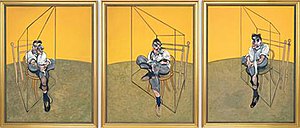Three Studies of Lucian Freud
 |
|
| Artist | Francis Bacon |
|---|---|
| Year | 1969 |
| Medium | Oil on canvas |
| Subject | Lucian Freud |
| Dimensions | 198 cm × 147.5 cm (78 in × 58 in); for each canvas |
| Owner | Elaine Wynn |
Three Studies of Lucian Freud is a 1969 oil-on-canvastriptych by the Irish-born British painter Francis Bacon, depicting artist Lucian Freud. It was sold in November 2013 for US$142.4 million, which at the time was the highest price attained at auction for a work of art when not factoring in inflation. That record was surpassed in May 2015 by Version O of Picasso's Les Femmes d'Alger series.
Bacon and Freud were friends but artistic rivals. Introduced in 1945 by artist Graham Sutherland, they swiftly became close friends who met frequently. The two artists painted each other several times, starting in 1951, when Freud first sat for Bacon. Two full-length triptychs of Freud by Bacon resulted. Three Studies of Lucian Freud is the later of the two; the first one, created in 1966, has not been seen since 1992. They form part of a series of large triptych portraits of Bacon's friends painted in the 1960s; other subjects include Isabel Rawsthorne, Muriel Belcher and his partner George Dyer. Bacon and Freud's friendship ended after an argument in the mid-1970s.
All three panels, in Bacon's typical abstract, distorted, isolated style,show Freud sitting on a cane-bottomed wooden chair within a cage, on a curved mottled-brown surface with a solid orange background. Behind each figure is a headboard of a bed, originating in a set of photographs of Freud by John Deakin which Bacon used as a reference.Michael Peppiatt writes "Trapped here in a series of Baconian cages, a contorted Freud hovers from panel to panel like a coiled spring about to shoot out of the flat, airless picture plane." The central panel portrays the figure face on, in a pose similar to that Bacon used for George Dyer, his lover. Brett Gorvy of Christie's considers the work to represent "a marriage of the incredibly important people in Bacon's life." The three canvases of the triptych are the same size and are each individually framed. The colouring is brighter than is typical of Bacon's works.
...
Wikipedia
